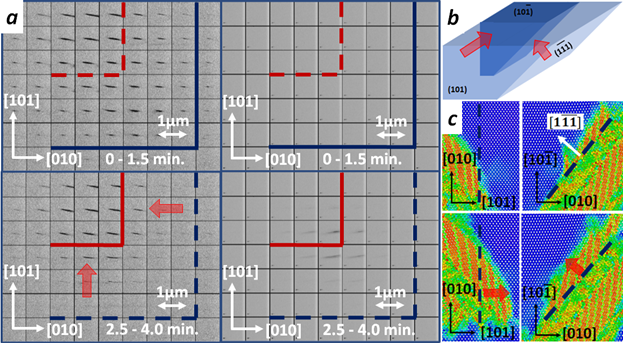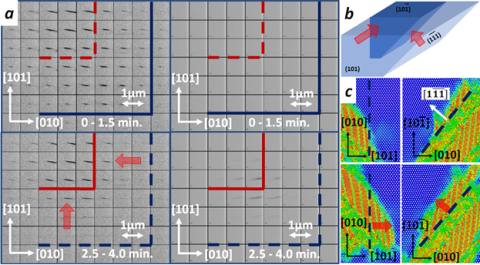Nontrivial Nanostructure Drives the Si-I to Si-II Transformation at High Pressures
A recently published work that combines molecular dynamics simulations, crystallographic theory generalized for strained crystals, and in-situ real-time Laue x-ray diffraction, reveals unprecedented nanostructure evolution during pressure-induced Si-I→Si-II phase transformation. The research effort was led by a long-time HPCAT user Professor V. Levitas, (Anson Marston Distinguished Professor in Engineering/Vance Coffman Faculty Chair Professor in Aerospace Engineering at ISU and staff member at Ames National Laboratory) and his former Ph.D. student Hao Chen (now a Professor at East China University of Science and Technology, Shanghai, China). The collaborative effort with HPCAT-colleagues, Dmitry Popov and Nenad Velisavljevic, was recently published in Nature Communications in the paper, “Nontrivial nanostructure, stress relaxation mechanisms, and crystallography for pressure-induced Si-I → Si-II phase transformation”. https://doi.org/10.1038/s41467-022-28604-1
Due to large and highly anisotropic transformation strains, the observed nanostructure at the transition in silicon does not obey the equations of the classical crystallographic theory. Thus, instead of minimizing lattice incompatibility and elastic energy at the unique irrational interface between semiconducting Si-I and twin-related variants of the metallic Si-II, unexpected nanobands, consisting of alternating strongly deformed and rotated residual Si-I and the third variant of Si-II, form {111} interface with Si-I. The new basic principle that governs such counterintuitive nanobands and interfaces is to produce an almost self-accommodated nanostructure that minimizes elastic energy of the long-range stresses in bulk, tolerating high short-range stresses at complex interfaces which are necessary to keep residual Si-I and reduce the resultant volume discontinuity. The interfacial bands arrest the {111} interfaces, leading to repeating the nucleation-growth-arrest process. This in turn results in a growth of the new phase by propagating (110) interface. Traditional crystallographic theory would not have predicted either of the two processes.
High-pressure Laue diffraction and molecular dynamics simulations have completely different spatial and time resolutions, and generally would not correlate with each other. However, this research shows major agreement between these two approaches for the observed counterintuitive nanostructure. Such in-situ experimental measurements coupled with molecular dynamics, and theoretical approaches open opportunities to study other high-pressure transformations in Si and Ge, C, BN, and BCN systems and suggest revisiting other transitions involving high strain which have been studied using modern phase-field approaches to account for nanostructures that may have been ignored.

The editors at Nature Communications have featured this article on their Editors’ Highlights page: https://www.nature.com/collections/eecgdgijhh
Chen, H., Levitas, V.I., Popov, D. et al. Nontrivial nanostructure, stress relaxation mechanisms, and crystallography for pressure-induced Si-I → Si-II phase transformation. Nat Commun 13, 982 (2022). https://doi.org/10.1038/s41467-022-28604-1

